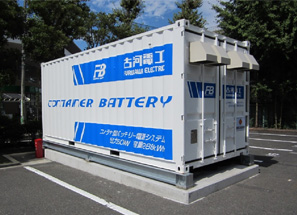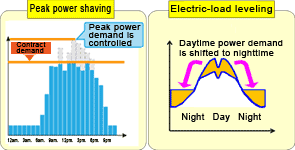October 16, 2012

A container for the package-type storage battery system
We have developed a package-type storage battery system to efficiently control the charging and discharging of storage batteries. A test for the operation of the system has been commenced at our Yokohama Works. In the event of a power outage, the package-type power storage system functions as an emergency power source to keep electrical equipment operating at the minimum level necessary. Usually, it helps use electricity efficiently in the form of peak shaving and the utilization of nighttime power. If connected to a solar photovoltaic panel, the system also makes it possible to adjust the time of electricity consumption and use surplus power to recharge the battery.
After an operation test at our facility, the system will be commercialized from the end of this fiscal year for public organizations, private enterprises, system manufacturers and developers that are considering anti-disaster actions.
Necessity of power storage systems
The Great East Japan Earthquake has renewed our awareness of the necessity for storage batteries for use in keeping important facilities operating in the event of a disaster or planned power outage, and in securing power sources for local community centers, schools and other evacuation locations. This type of battery can be charged when surplus power is available and discharged when the availability of power is limited, both during emergencies and under normal operating conditions. This helps power resources to be used wisely in ways such as those described below.

- During peak hours in the daytime, discharge as much as possible exceeding the contract demand so that the peak power demand can be controlled;
- Charge the battery and increase the power for electrical appliances that need to be powered 24 hours per day at nighttime when power consumption is low; and
- Use surplus power to charge the battery when surplus photovoltaic power is available, for example on fine holidays.
Using these functions to eliminate the power differences between daytime and nighttime and efficiently utilize power supply facilities can be expected to enhance the efficiency of equipment investment and contribute to the overall local economy. Peak shaving also represents an advantage for users, as it helps to reduce basic electricity rates and partly recover their equipment investment with the use of equipment to ensure security and safety.
The mass introduction of photovoltaic power and other natural energy sources has led to concern regarding growing instability within systems. Systems with storage batteries are a viable solution to this problem, so this is a further reason why they are increasingly considered to be necessary.Functions and specifications of the system
To achieve these functions, we have developed a package-type storage battery system. Integrating a storage battery, control device and other major devices into a container, the system has the following functions.
Functions of the system
| Item | Description |
|---|---|
| Automatic power supply in the event of a power outage | Power outages and isolated operations are detected and power supply to important equipment begins automatically.(note 1) |
| Peak shaving | If the 30-minute power demand exceeds a predetermined value, the discharge of electricity corresponding to the power excess begins automatically so that peak power demand can be reduced.(note 2) The storage battery and/or the solar photovoltaic panel is/are available as a power source. |
| Use of surplus electricity and nighttime electricity for charging | Surplus power from solar photovoltaic generation is used to charge the storage battery. The battery may also be charged from the power distribution system at nighttime when electricity rates are low. |
| Cooperation with photovoltaic power generation | When the system is connected to the power distribution system, the outputs from solar photovoltaic generation and the storage battery are combined to partly supply the power for consumption by the equipment in the building.(note 3) The power discharged from the storage battery supplements the variations in the fluctuations of photovoltaic power. This ensures that the power supply to the equipment settles at the same value. |
(note 1)
A blackout continues for around ten seconds before the automatic power supply begins. Install UPS in each device, such as computers, where power outages are not acceptable.
(note 2)
If the power excess is greater than the rated value for this product, the contract demand may be exceeded. Be sure to consider the capacity of the equipment before designing the capacity.Back to Main Content
(note 3)
In this operational test, no reverse power flow to the system is performed.Back to Main Content
Specifications of the equipment
| Item | Specifications | Remarks | |
|---|---|---|---|
| Storage battery | Model | FCP-1000 (The Furukawa Battery Co., Ltd.) | Dedicated to cycled use, long service life |
| Type of storage battery | Stationary lead-acid battery with control valve | ||
| Energy capacity | 288kWh (10-hour rate) (note 4) | ||
| Maximum charging time | 4.4hours (50kW discharge)(note 4) | ||
| 72hours (4kW discharge)(note 4) | |||
| Inverter | Output power mode | Three-phase three-wire system | Single-phase two-wire auxiliary output (AC100V, 4kW) is available |
| Rated output | 50kW, AC 200V(note 4) | ||
| Rated frequency | 50/60Hz | ||
| Rated input (photovoltaic generation) |
50kW, DC(note 5) | Maximum power point tracking is available | |
| Rated input/output (storage battery) |
50kW, DC(note 6) | ||
| Charging mode | Constant voltage and constant current(note 7) | ||
| Conversion efficiency | 90% or more | The charge/discharge efficiency of the storage battery is excluded | |
| Outdoor housing (note 7) |
External dimensions | L (length): 606cm W (width): 244cm H (height): 266cm |
20-foot container |
| Weight | 15 tons (including the battery) | 5 tons without the battery | |
(note 4)
If you require a product with a different capacity, please contact us.Back to Main Content
(note 5)
The value represents the maximum rating for input power. The maximum rating for the AC output cannot be exceeded for the output.Back to Main Content
(note 6)
The recovery charging of the lead-acid battery begins automatically.Back to Main Content
(note 7)
Environmental temperature: -10 to 40 degrees. If you wish to use it within a higher or lower temperature range, please contact us.Back to Main Content
Inquiries about the system
Smart Grid New Business Development Department, Furukawa Electric Co., Ltd. smartgrid@furukawa.co.jp